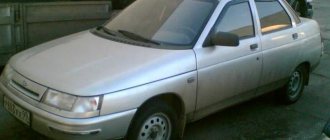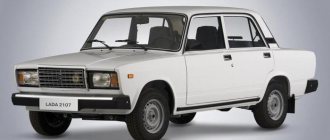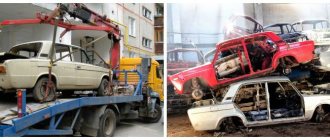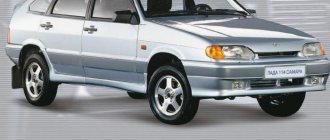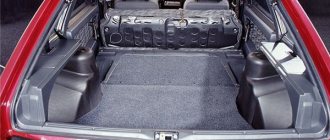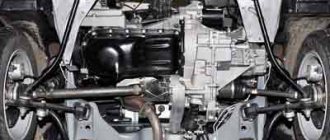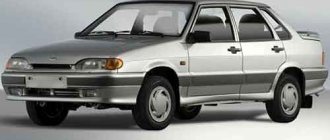The popularity of domestic cars is due to cost, availability of spare parts and efficiency. Each of the Volzhsky Automobile Plant models has standardized parts in its design, making repairs even more accessible. There is no need to talk about the quality of materials and main units, but some technical indicators are quite good even in comparison with foreign cars. We will consider the technical characteristics of the VAZ 2114 in detail below.
Useful video:
Improved aerodynamics
The VAZ 2114 car excels in aerodynamic characteristics thanks to its well-designed body lines, providing excellent streamlining. As a result of the change in appearance, the drag coefficient has decreased.
External aerodynamic improvements of the Lada2114Samara-2 also affected changes in the position of the air flow separation point. To do this, the designers had to change the angle of inclination of the most aerodynamically active front part of the car - the hood. The front fenders have also undergone changes.
Power plant of the VAZ 2114 car
As a result of the redistribution of the air flow, a smaller part of it is directed under the bottom, while the larger part is directed onto the hood and spreads over the body. These characteristics change the amount of total lift force, as a result of which the front and rear axles are unloaded. The even distribution of lift force allows the hatchback to behave in a balanced manner during high-speed driving.
Maintenance schedule
To avoid having to carry out expensive overhauls of the Lada Samara 2114 yourself, you should follow the manufacturer’s recommendations for servicing the internal combustion engine:
| Maintenance object | Time or mileage (whichever comes first) |
| Timing belt | replacement after 100,000 km |
| Battery | 1 year/20000 |
| Valve clearance | 2 years/20000 |
| Crankcase ventilation | 2 years/20000 |
| Belts that drive attachments | 2 years/20000 |
| Fuel line and tank cap | 2 years/40000 |
| Motor oil | 1 year/10000 |
| Oil filter | 1 year/10000 |
| Air filter | 1 – 2 years/40000 |
| Fuel filter | 4 years/40000 |
| Heating/Cooling Fittings and Hoses | 2 years/40000 |
| Coolant | 2 years/40000 |
| Oxygen sensor | 100000 |
| Spark plug | 1 – 2 years/20000 |
| Exhaust manifold | 1 year |
If consumables are replaced within the recommended time frame, the operational life of the internal combustion engine will increase.
Exterior and interior characteristics
The car's interior is equipped with a "European" instrument panel, an adjustable steering column, a new heating system and a steering wheel borrowed from the VAZ 2110 model. It is possible to turn the car into a utility vehicle; to do this, you only need to fold out the rear seat.
Additional appearance improvements and new options include:
- Installation of electric windows;
- Comfortable heated seats;
- Equipment with central door locking;
- Availability of factory tinted glass, produced in accordance with GOST;
- Providing threshold fairings, side moldings;
- Providing wheels with alloy discs;
- Availability of fog lights.
The equipment of the “luxury” Lada 2114 Samara-2 models includes an on-board computer that provides accurate information on average speed, fuel consumption, driving time, outside temperature, voltage in the on-board network and other parameters.
Modified Lada Samara
Other parameters of VAZ 2114:
| Total weight of the VAZ 2114 car | |||
| General view General view of the car | Curb weight min (kg) Minimum vehicle weight for different modifications of VAZ 2114 | ||
Data are presented in kilograms (kg)
Caution: the above data are official figures from manufacturers, however, please note that the information is for reference only and does not guarantee absolute accuracy.
Source
General technical specifications
Individual technical characteristics that distinguish the “fourteenth” hatchback from its predecessors are the parameters of the five-door body. Its length is 4,122 meters, width – 1,650 m, height – 1,402 m. The car differs from the base model (VAZ 21093) by a slight extension. Machine weight – 985 kg.
The wheelbase is characterized by a width of the front wheels of 1.4 meters, the rear wheels – 1.37 meters. The trunk (with the rear seat up) has a volume of 330 dm³, with the rear seat folded down – 600 dm³.
The clearance from the asphalt to the crankcase is 160 mm, to the pan the clearance is 10 mm more.
| Engine | 1.6 l, 8 cells (Euro-3) |
| Length, mm | 4122 |
| Width, mm | 1650 |
| Height, mm | 1402 |
| Base, mm | 2460 |
| Front wheel track, mm | 1400 |
| Rear wheel track, mm | 1370 |
| Luggage compartment volume, dm3 | 330 |
| Weight in running order, kg | 985 |
| Gross vehicle weight, kg | 1410 |
| Permissible total weight of a towed trailer with brakes, kg | 750 |
| Permissible total weight of the lettered trailer without brakes, kg | 300 |
| Wheel formula/drive wheels | 4x2/front |
| Car layout diagram | front-wheel drive, front engine, transverse |
| Body type/number of doors | hatchback/4 |
| engine's type | gasoline, four-stroke |
| Supply system | Electronically controlled distributed injection |
| Number and arrangement of cylinders | 4, in-line |
| Engine displacement, cm3 | 1596 |
| Maximum power, kW/rpm | 59,5/5200 |
| Maximum torque, Nm at rpm | 120 / 2700 |
| Fuel | unleaded gasoline AI-92 (min) |
| Fuel consumption by driving cycle, l/100 km | 7,6 |
| Maximum speed, km/h | 160 |
| Transmission | With manual control |
| Number of gears | 5 forward, 1 reverse |
| Main gear ratio | 3.7 or 3.9 |
| Steering | safety, rack and pinion type, without amplifier |
| Tires | 175/70R13-80(T,N) 165/70R13-79(S,T) |
| Fuel tank capacity | 43 liters |
Weight of VAZ 2114
For most modifications of the VAZ 2114 hatchback, the weight with all the regulatory equipment, a filled fuel tank and a driver in the cabin varies from 970 (kg) to 985 (kg).
Hatchback weight:
A lot of modifications of the VAZ 2114 (2001 - 2013):
- Curb: 970 (kg), 985 (kg).
- Full permissible: 1410 (kg).
Model VAZ 2114:
The five-door class B hatchback was produced by the Russian company AvtoVAZ from 2001 to 2013, the model was also assembled in Ukraine at the ZAZ plant, possible layout: front-engine or front-wheel drive, seats - 5.
Important: for most modifications of the VAZ 2114 hatchback, the weight with a driver and four passengers, the maximum permissible load, equipment, fuel, and consumables is 1410 (kg).
Other names:
Other designations for the VAZ 2114 hatchback on the Russian market: VAZ 2108, VAZ 2109, VAZ 2113, Lada Samara.
Years of production Years of production of all modifications of the model: 2001-2013.
Features of the power unit
The first “fourteenth” VAZ models were equipped with injection engines characterized by a displacement of 1499 cm³ and a power of 57.2 kW. Since 2007, under the hood of the Lada 2114 Samara-2 there was a four-stroke gasoline engine with a displacement of 1599 cm³, providing a power of 59.5 kW or 80 hp. With. This engine met the parameters of the Euro 3 eco-standard. The latest modernized model with the index 211440-24 has a sixteen-valve engine with an output of 89 horsepower.
Sectional view of the power unit
The power supply system using distributive (phased) injection provides high dynamic capabilities, ensuring acceleration to 100 km/h in just 13 seconds. The maximum speed of the VAZ 2114 is 160 km/h. At the same time, the car consumes gasoline economically - only 9 l/100 km in the city.
A special feature of the engine characteristics of this model is the original location of the ceramic catalyst - near the engine itself (unlike its predecessors, which had a catalyst under the bottom). The difference between the cylinder block of the VAZ engine of the “fourteenth” model Lada Samara-2 is its changed volume, achieved by increasing the height of each of the cylinders by 0.23 cm.
Story
VAZ 2114 is the brainchild of the domestic giant AvtoVAZ. The 14th model is built on the basis of the VAZ 2109 Samara and is its deep restyling; if you look closely, you can see the great similarity between these two models; the fourteenth received the additional name Samara 2. “The Nine made a lot of noise in the 90s and was a very popular car , everyone wanted her, but not everyone could afford her. Fortunately, times have changed and cars have become much more affordable.
2114 began production back in 2003 to 2013. During this period of time, the 14th model was restyled only once in 2007. In 2007, a more powerful engine was installed on this model and the appearance of the car was slightly changed.
This article will discuss the technical characteristics of the VAZ 2114.
Transmission and chassis
All front-wheel drive cars of the VAZ family have a fundamentally similar chassis design. The front suspension is based on the MacPherson system, the rear suspension is a trailing arm. The steering, typical for all models, is rack and pinion.
Lada 2114 Samara-2 is equipped with a manual gearbox. The car is equipped with a five-speed gearbox (gearbox) with a rocker drive. Fundamentally, its design is similar to all those installed on other vase models. The main pair has a distinctive gear ratio of 3.7.
Weight of VAZ 2114 bodies
The weight of the body of the five-door hatchback VAZ 2114 1.6 MT 21144 after assembly line assembly is 985 kg.
Model body weight:
Body weight of hatchback modifications:
- VAZ 2114 1.5 MT 21140 (2001 – 2013): 970 kg.
- VAZ 2114 1.6 MT 21144 (2007 – 2013): 985 kg.
- VAZ 2114 1.6 MT 211440-24 (2007 – 2013): 985 kg.
- VAZ 2114 1.6 MT 211440-26 (2010 – 2013): 985 kg.
Additionally:
The Russian automobile manufacturer AvtoVAZ equips VAZ 2114 hatchbacks with monocoque bodies (frameless), which have a closed power structure (a closed loop is formed due to the presence of a roof, bringing together all vertical power elements).
Important: the body weight of VAZ 2114 hatchback modifications varies from 970 kg to 985 kg.
Other names:
Other designations for the VAZ 2114 hatchback on the Russian market: VAZ 2108, VAZ 2109, VAZ 2113, Lada Samara.
Years of production Years of production of all modifications of the model: 2001-2013.
Design
All modifications of the engine installed on the VAZ 2114 have a block cast from cast iron and a fuel injection system. Despite the design solutions used to improve dynamic and environmental performance, the design of the VAZ 2114 engine has retained its simplicity and reasonable maintenance cost.
Operation and resource availability
An oil change should be done every 9-11 thousand km. Regardless of the modification, 3.2 liters will be required to change the oil. Recommended viscosity: 5W-30, 10W-40, 5W-40, 15W-40.
According to the manufacturer, the engine life is 150 thousand km. (200 thousand km for Priora motor). Practice has shown that with proper maintenance, the engine can cover up to 250 thousand km.
Failure to comply with maintenance standards and improper tuning of the VAZ 2114 engine significantly reduces its service life.
Features and Disadvantages
1.5l:
- after a timing belt breaks, the valves remain unharmed;
- Regular adjustment of valve clearances is required;
- wear of cooling system components;
- oil leaks from under the valve cover;
- oil leakage from under the ignition distributor and fuel pump;
- poor fastening of the exhaust manifold (solved by replacing steel nuts with brass ones);
- unreliability of early injection systems.
1.6l:
- A broken timing belt does not deform the valve;
- the need for periodic valve adjustment;
- increased noise and vibration load.
16V 1.6i l (124):
- Thanks to the holes on the pistons, even with moderate sports shafts, if the timing belt breaks, the valves do not bend;
- Every 15 thousand km you need to tighten the timing belt.
16V 1.6i l (126):
- a broken timing belt leads to bending of the valves (the problem can be solved by installing plug-free pistons.
Popular faults
Due to the imperfect quality of the unit and the large number of low-quality spare parts, the motor and attachments require increased attention.
Main problems and possible causes:
- Unstable idling of the VAZ 2114, the engine stalls after starting. Cause – Coking of the idle speed controller (IAC), throttle position sensor, vacuum seal “drizzle”, unreliable signals from the mass air flow sensor;
- Starting has deteriorated, the engine is running rough - the reason may be: incorrect valve adjustment, lack of compression in one of the cylinders (the valve may have burned out), wear of the valve springs, air leaks (check the connections of the hoses and pipes going after the mass air flow sensor and to the vacuum valve, valve hose purging of the absorber, tight fit of the injectors to the cylinder head), malfunction of the ignition module, spark plugs do not produce a spark, inoperability of high-voltage wires, incorrect valve timing (the timing belt may have slipped a few teeth);
- The VAZ 2114 engine has lost throttle response and does not pull. The breakdown is possible due to a malfunction of the ignition module (symptoms appear when the engine is warm), a clogged catalyst, the fuel pump does not create the required pressure, a dirty air filter, air leaks, carbon deposits on the spark plugs, lack of compression;
- Extraneous knocking, noise and vibration of the VAZ 2114 engine. Breakdown may occur because valve clearances need adjustment, sagging valve springs, sagging seats, wear of the main bearings of the crankshaft or connecting rod bearings (it is possible that the pistons themselves are knocking), hydraulic compensators, wear of the engine mounts (pillows);
- Does not show the engine temperature of the VAZ 2114. Occurs due to a malfunction of the coolant temperature sensor (the sensor screwed into the cylinder head is responsible for the readings on the instrument panel), open circuit, oxidation of contacts, a malfunction in the indicator on the dashboard;
- The engine is heating up. Thermostat failure (liquid circulates only in the engine cooling jacket). When buying a thermostat, look in the instructions for what engine operating temperature it is designed for (for the engines in question this is 95-103 degrees); Damage to the water pump impeller, malfunction of the fan switch sensor, or the fan itself does not work.

